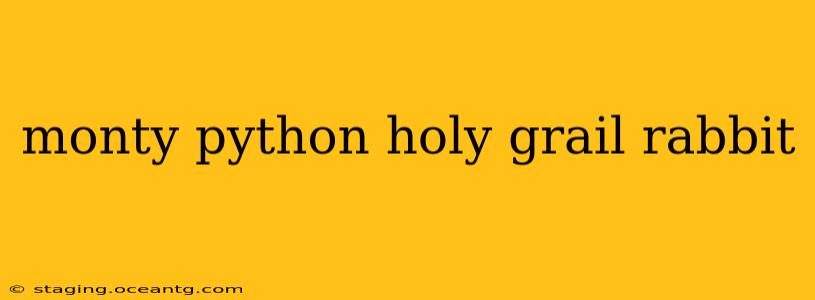The Monty Python and the Holy Grail film, a cornerstone of British comedy, is packed with memorable moments. But few scenes achieve the same level of iconic status as the encounter with the Killer Rabbit of Caerbannog. This seemingly innocuous creature, a fluffy white rabbit, becomes a symbol of unexpected peril, showcasing the film's masterful blend of absurdity and genuine suspense. This post will explore the rabbit's lasting impact, delve into its creation, and answer some frequently asked questions.
What Makes the Killer Rabbit So Memorable?
The Killer Rabbit's impact transcends mere comedic effect. Its unexpected ferocity, juxtaposed with its adorable appearance, creates a jarring yet hilarious dissonance. This subversion of expectations is a hallmark of Monty Python's humor. The scene effectively uses visual gags, sound effects, and surprisingly realistic (for the time) special effects to build tension and deliver a punchline that lands with comedic force. Furthermore, the scene perfectly encapsulates the film's overall theme: the absurdity of quests and the unexpected dangers encountered along the way.
Was the Killer Rabbit a Real Rabbit?
No, the Killer Rabbit of Caerbannog was not a real rabbit. While a real rabbit was likely used in some shots, the more intense scenes featuring the rabbit's ferocious attacks were achieved through stop-motion animation, a technique that adds to the scene's surreal and unsettling quality. The combination of practical effects and animation perfectly captures the blend of the realistic and the fantastical that defines Monty Python and the Holy Grail.
What Kind of Rabbit is the Killer Rabbit of Caerbannog?
The film never explicitly states what kind of rabbit the Killer Rabbit is. Its appearance is that of a fluffy white rabbit, yet its behavior is far from typical. This ambiguity adds to the creature's mystique and enhances the comedic effect of its unexpectedly violent nature. The lack of specific identification allows viewers to project their own interpretations onto the creature, further solidifying its place in pop culture.
Why is the Killer Rabbit So Deadly?
The deadly nature of the Killer Rabbit is never explicitly explained. This is in keeping with the film's overall nonsensical yet hilarious approach. Its lethality is simply a given, a fact accepted by the characters without question. The humor stems from the contrast between the rabbit's innocent appearance and its brutal efficiency at dispatching foes, highlighting the film's knack for turning the mundane into the unexpected.
How Did They Film the Killer Rabbit Scene?
The scene involved a combination of techniques. Some shots likely utilized a real rabbit, while the more dramatic moments featuring the rabbit's attacks were achieved using stop-motion animation. This required painstaking work by the film's crew, frame by frame, to create the illusion of movement and violence. The blend of practical and special effects contributes significantly to the scene's unique and memorable style.
What is the Significance of the Killer Rabbit's Role in the Film's Narrative?
The Killer Rabbit scene serves multiple purposes within the film's narrative. Firstly, it acts as a significant obstacle for Arthur and his knights, highlighting the unpredictable and often absurd nature of their quest. Secondly, it showcases the bravery (or foolhardiness) of Sir Galahad, who ultimately confronts the rabbit. Finally, the scene is a comedic highlight, providing a memorable and often quoted moment of absurd violence.
Conclusion: The Enduring Legacy of the Killer Rabbit
The Killer Rabbit of Caerbannog remains a cultural touchstone, a symbol of unexpected peril and absurd humor. Its enduring popularity is a testament to the enduring power of Monty Python's comedic genius. The scene continues to be quoted, referenced, and imitated, demonstrating its profound influence on popular culture. Its unexpected violence and delightfully absurd nature solidify its place as one of cinema's most memorable and beloved comedic moments.
